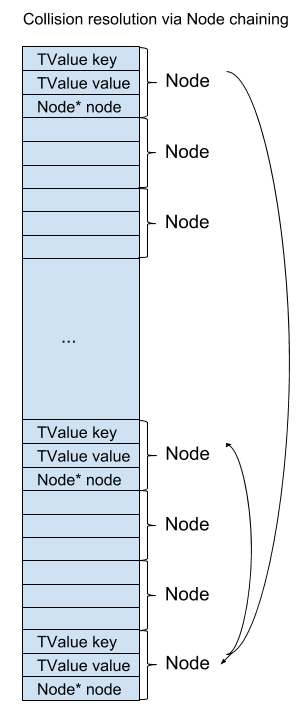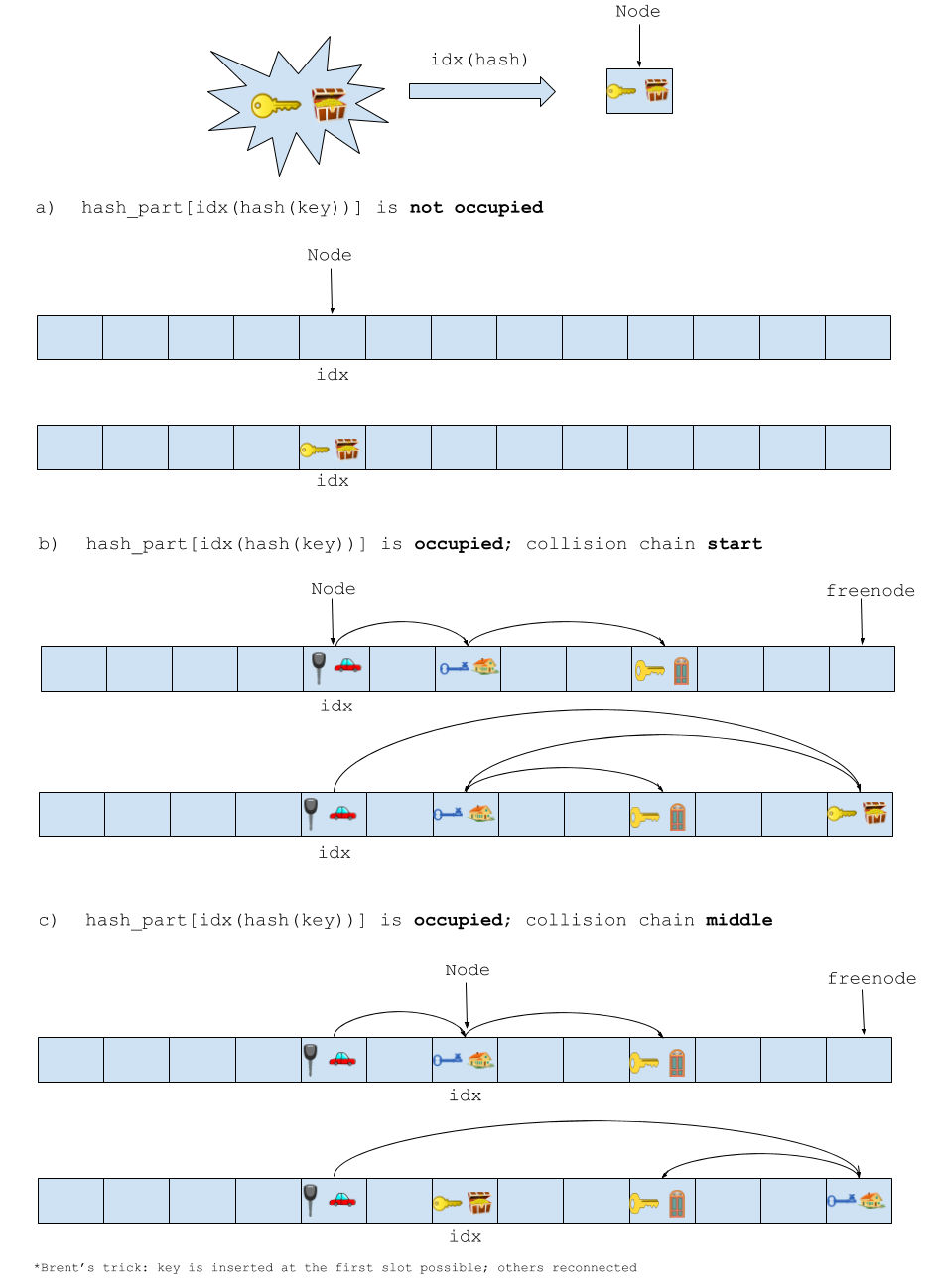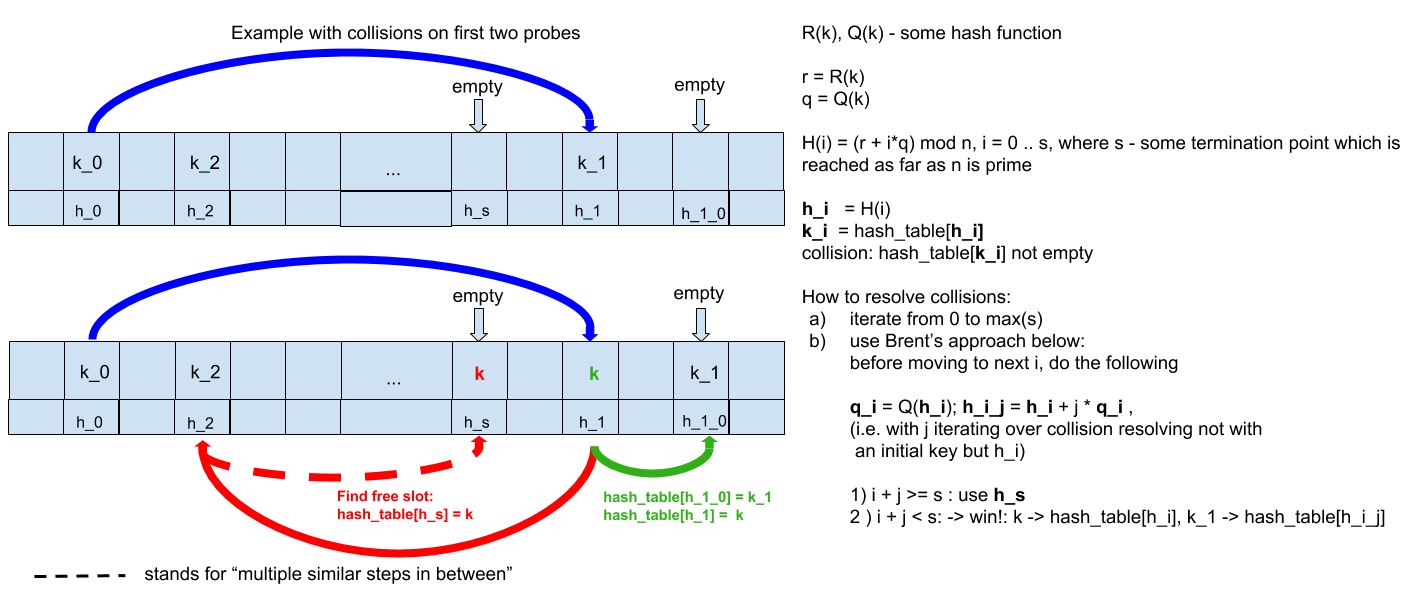Tutorial: GCtab¶
Iteration¶
One type of table iteration is handled in VM in BC_ITERN.
Starting part of its code is below with comments on how the instructions and some interesting details pointed out:
case BC_ITERN:
| ins_A // RA = base, (RB = nresults+1, RC = nargs+1 (2+1))
|.if JIT
| // NYI: add hotloop, record BC_ITERN.
|.endif
| mov TMPa2, KBASE // Need two more free registers.
| mov TMPa, DISPATCH
// Table pnt is put into RBa.
// The following arithmetic is applied here:
// RA (see above) contains offset from BASE where table object resides.
// Formula below stands for
// mov acc, qword [base + off_1*TVS_X2 + (off_2)*TVS]
// where
// TVS_X2 == 16
// TVS_X == 8
// i.e.
// qword [base + BASE * 16 - 2*8]
// where
// the first part stands for offset from the BASE of stack
// moving backwards one TValue (i.e. 16)
// and qword is 8 bytes.
// This brings us to the 'first' part of TValue structs in its
// payload version.
| i2gcr TAB:RBa, BASE, RAa, -2
// Following the previous calculation, it's clear that
// RC is assigned the 'second', tag value of the same TValue slot
// This slot is meant to keep control value i.e. iteration counter.
// NB: tag value of this TValue can be disregarded i.e. it's already
// known beforehand that the value under scrutiny is a table.
| __i2gcr RC, BASE, RAa, -1
| mov DISPATCHd, TAB:RBa->asize
| inc_PC
// KBASE is assigned array part.
| mov KBASE, TAB:RBa->array
|1: // Traverse array part.
| cmp RC, DISPATCHd; jae >5 // Index points after array part?
// AUX1 is assigned next element in array part.
| n2tvp_r AUX1, KBASE, RCa
// Element in AUX is compared to NIL.
// Literally, this comparison is: comparing next element in array part to NIL value
// as array part can contain NIL-s or so-called 'holes'.
// NB: two important points here:
// 1. dword is used as array part contains elements of int32_t type
// 2. AUX + 8 as NIL is basically a TAG (~0). For payload version of TValue
// tag resides in the second part in 'value_tag' member.
// As this '+' operates on addresses, it stands for '+ 8 bytes'. Thus, it's clear then
// that AUX + 8 points to this second part of TValue.
// Thus the comparison is actually a check that current TValue is a NIL value.
//
// NB: this iteration inspection can help figuring out that actual array size in GCtab is
// asize + 1.
// If you inspect this code chunk with gdb, it'll be clear that first iteration is jumps to 4
// i.e. the very first element of the array i.e. the one in *array is NIL.
// Of course, the latter fact can be figured out from the GCtab code as well.
| cmp dword [AUX1+8], LJ_TNIL; je >4
| cvtsi2sd xmm0, RC
| // Copy array slot to returned value.
| i2tvp AUX1, BASE, RAa, 1
Layout¶
GCtab struct definition¶
struct GCtab {
GCHeader;
uint8_t nomm;
int8_t colo;
uint32_t unused;
TValue *array;
GCtab *metatable;
GCobj *gclist;
Node *node;
size_t asize;
size_t hmask;
Node *freetop;
};
GCtab struct description¶
Details¶
To understand what each component stands for, basic table characteristics should be outlined:
- table can serve as an array and a hash-map at the same time. Thus, it has both array and hash parts.
- being a core type in Lua, table has a special functionality of metatables (which is a table itself with keys treated in a special way).
Fields annotation¶
After these details, descriptions below should be entirely clear:
| Field | Description |
|---|---|
GCHeader |
Garbage collection dedicated part of object type in Lua. Used for GC housekeeping purposes (layout details). |
uint8_t nomm |
Negative metamethod cache. Array to track whether there is no metamethod for a table. It’s of fixed size because the set of metamethods is known beforehand. |
int8_t colo |
Size of collocated array which is a sequential part of a table stores straight after the table object body. Such a trick is utilized in case sequential part is of moderate (i.e. asize <= LJ_MAX_COLOSIZE (16) ) size. In this case, instead of two allocations (via malloc), just one works out. |
uint32_t unused |
32-bit padding. |
TValue *array |
Sequential part when it has not been collocated. |
GCtab *metatable |
Metatable. |
GCobj *gclist |
List of garbage collectible objects. |
Node *node |
Hash part is implemented as a hash table of node’s. For collisions resolution, Node s’ chains are maintained. However, they are stored not within external lists but within hash table itself. Collisions which occur on insertions are resolved with Brent variation of collisions’ resolution algorithm (original paper, slides with pictures). |
size_t asize |
Array part size i.e. count of elements. However, as elements enumeration starts from 1, implementation motivated actual size is asize + 1 (see Tutorial: for-iterators for details). |
size_t hmask |
Mask to get the index in hash array. Technically, hsize = 2^i → hmask = 2^i - 1 → hashed & hmask = hashed mod hsize → idx. |
Node *freetop |
When hash part is not empty, keeps pointer to the last node in the Node chain. Used for quick access to the last stored element when adding new keys. |
asize can be 0 in which case there is no collocated part.

Implementation internals¶
Array part¶
<contents pending> For the array part, key field is unnecessary as sequential indexing is used.
Hash part¶
Hash part consists of nodes of the following type:
Node struct¶
/* Hash node. */
typedef struct Node {
TValue val; /* Value object. Must be first field. */
TValue key; /* Key object. */
struct Node* next; /* Hash chain. Required for collision resolving. */
} Node;
Hash implementation internals¶
On lookup, key is searched first in the slot by idx(hash(key)) and
further look-up is proceeded through the chain of Node-s:

On insertion, collisions are resolved in the following way:

